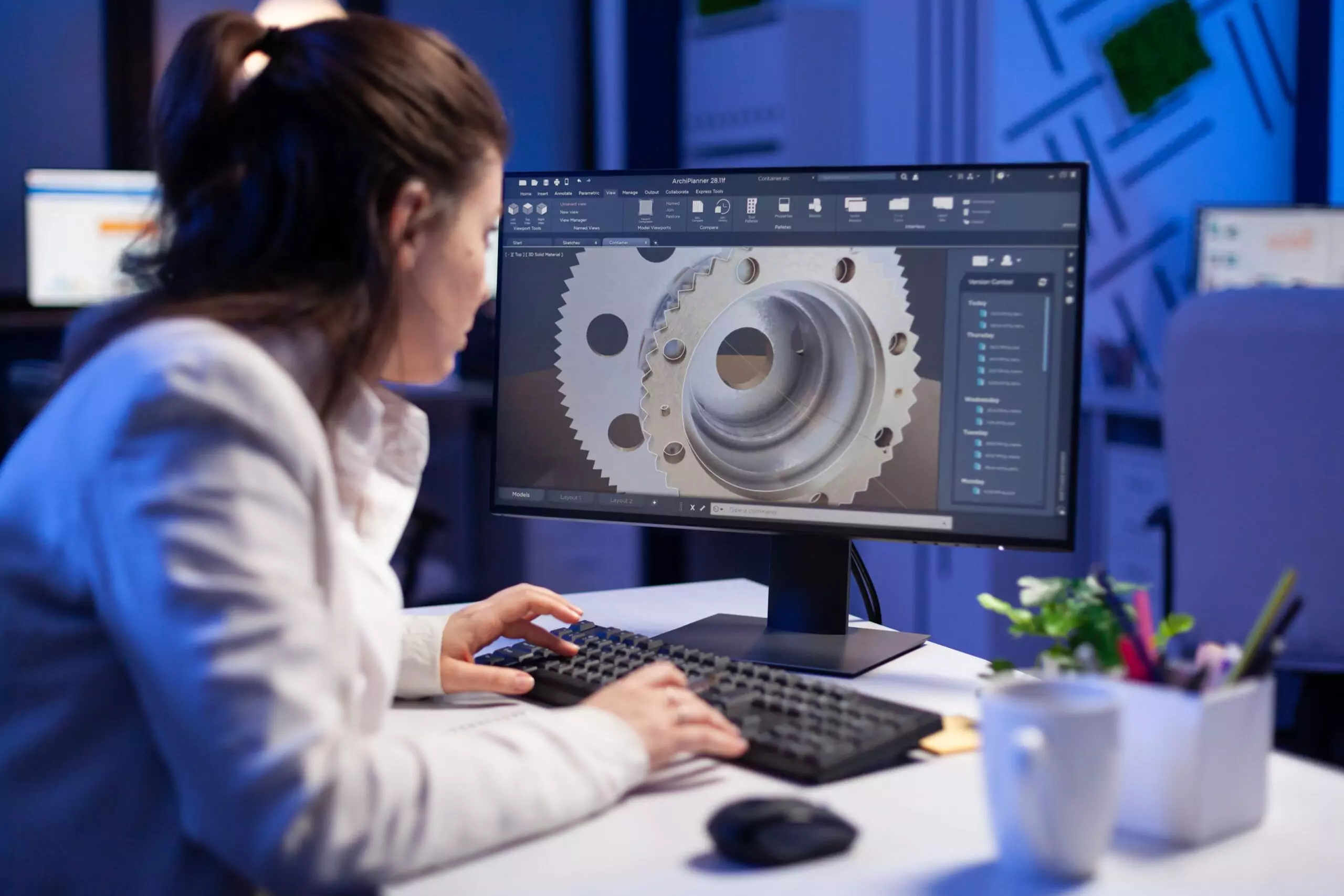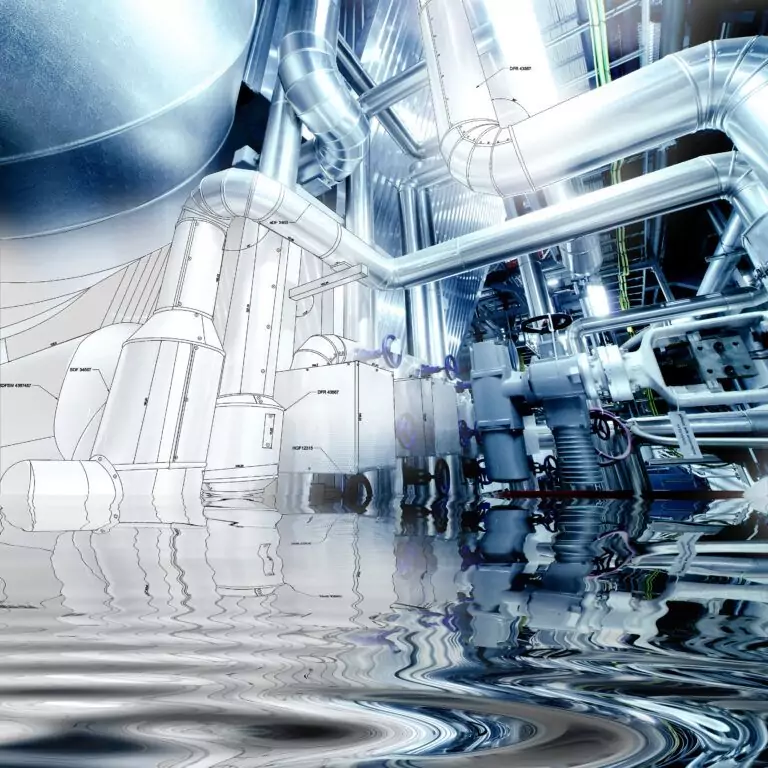Mechanical engineers face a maze of software choices. Hundreds of platforms promise to revolutionise workflows, yet most engineering teams end up with disconnected tools that create more problems than they solve. Files don’t translate cleanly between programs. Drawing revisions get lost across departments. Calculations need constant rework because someone used incompatible software.
The real problem isn’t finding powerful software. It’s finding tools that connect seamlessly across your entire project lifecycle. From initial concept through detailed design, fabrication drawings, and final commissioning, your software ecosystem needs to share data automatically. Process requirements must flow into mechanical calculations without manual transcription. Equipment models need to export cleanly to piping design systems. Structural loading data should update automatically when equipment specifications change.
Most engineering teams get this backwards. They select individual programs based on features and price, then spend years struggling with integration nightmares. The parametric CAD package looked impressive in the demo, but it can’t export geometry that piping designers can actually use. The finite element analysis tool produces beautiful results, but no one can verify that the boundary conditions match real operating conditions. The document management system tracks revisions perfectly, but engineers still email files because the software workflow takes too long.
This guide cuts through vendor marketing to show what tools actually matter in mechanical engineering jobs. You’ll learn which software categories deliver measurable value in industrial projects, how to avoid compatibility disasters that cost months of productivity, and what implementation mistakes derail even well-planned rollouts.
Disclaimer: Software capabilities, pricing, and licensing models change constantly. All information is based on available 2025 data. Check with vendors before making procurement decisions.
CAD Software That Powers Mechanical Design Workflows
CAD platforms (computer-aided design software) determine design iteration speed, collaboration efficiency across mechanical and electrical disciplines, and fabrication success rates.
Parametric Modelling Tools for Large Assembly Design
Three parametric CAD platforms dominate industrial mechanical design. SolidWorks excels at discrete manufacturing applications and assemblies under 1,000 components, offering intuitive interfaces and rapid modelling capabilities. Autodesk Inventor integrates tightly with AutoCAD-based electrical and piping teams. PTC CREO handles enormous assemblies with more than 10,000 components better than competing platforms, maintaining performance through advanced memory management and model simplification techniques.
Parametric modelling enables intelligent design modifications. Change a shaft diameter in one location, and dependent components like mounting brackets, mechanical seals, and coupling assemblies update automatically throughout the assembly. For capital projects with hundreds of equipment pieces, this automation saves massive amounts of engineering time.
The challenge comes when selecting the wrong tool for your specific needs. Engineers pick SolidWorks for its ease of use, then discover it bogs down on large assemblies that CREO would handle smoothly. Teams choose Inventor for AutoCAD compatibility, then realise the piping group uses a completely different platform anyway.
Geometry Export and File Format Compatibility
How your CAD tool exports geometry to downstream disciplines matters more than modelling speed. Process engineers require accurate equipment envelopes (3D spatial boundaries) for plant layout design. Structural engineers need precise weight calculations and centre-of-gravity coordinates for foundation design. Piping designers require exact nozzle locations with orientation data for connection routing. Most parametric tools handle these exports poorly out of the box.
File format compatibility makes or breaks multi-vendor projects. Neutral formats like STEP and IGES enable geometry exchange between different CAD systems, but they lose parametric intelligence in translation. Assembly relationships disappear. Design intent evaporates. The piping team receives a dumb solid that doesn’t show which dimensions are critical and which are flexible.
Industry-Specific CAD Requirements
Petrochemical facility projects demand specialised capabilities beyond general-purpose CAD. Pressure vessel modelling requires ASME Section VIII code compliance calculations built into the workflow. Specialised pressure vessel design software like Hexagon’s PV Elite and COMPRESS integrate directly with SolidWorks and Autodesk Inventor, automating stress analysis, nozzle reinforcement, and vessel thickness determination.
Mineral processing equipment presents different challenges. Crushers, grinding mills, conveyors, and classifiers involve massive rotating assemblies weighing hundreds of tons. These designs require CAD platforms with robust assembly management, kinematic motion simulation for interference checking, and structural analysis integration for dynamic loading from unbalanced forces.
CAM and Manufacturing Integration
Computer-aided manufacturing (CAM) software bridges the gap between design and fabrication. Tools like Autodesk Fusion 360, Mastercam, and Siemens NX CAM generate toolpaths for CNC machining directly from CAD models. The integration eliminates manual programming for complex geometries and reduces errors in translating design intent to manufacturing instructions.
Manufacturing engineers need CAM capabilities that understand both design geometry and shop floor constraints. Toolpath optimisation reduces machining time. Collision detection prevents expensive crashes. Post-processors generate machine-specific code for different CNC controllers. Select CAM software compatible with your CAD platform to maintain associativity between design changes and manufacturing programs.
Finite Element Analysis Tools for Design Validation
Hand calculations using established formulas from Roark’s Formulas for Stress and Strain provide preliminary design validation. Finite element analysis (FEA) verifies actual performance under complex loading conditions, including thermal stress, vibration, and combined load cases that defeat simplified calculation methods.
Structural Analysis Software Platforms
Two finite element analysis platforms dominate industrial mechanical equipment validation. ANSYS handles linear stress analysis of pressure vessels, structural supports, and rotating machinery. Most mechanical engineers achieve competency in basic linear static stress analysis after focused training covering mesh generation, boundary condition application, material property assignment, and stress result interpretation.
Dassault Systèmes Abaqus specialises in nonlinear analysis involving large deformations, contact mechanics, and material plasticity behaviour. Equipment operating near yield stress requires nonlinear analysis. Designs with tricky contact conditions where surfaces press together, slide, or separate need Abaqus capabilities that ANSYS handles poorly.
Code Compliance and Analysis Requirements
ASME Boiler and Pressure Vessel Code Section VIII, Division 2 (design by analysis), requires stress linearization, separating membrane, bending, and peak stresses. Fatigue analysis using stress categorisation methods and fatigue curves adds another layer of complexity. These workflows are built into ANSYS Mechanical with dedicated pressure vessel analysis modules that automate procedures reviewers expect to see.
When to Use FEA vs. Hand Calculations
Capital project documentation submitted for third-party engineering review requires defensible analysis methodologies. Roark’s formulas, AISC Steel Construction Manual procedures, and ASME pressure vessel code equations allow reviewers to verify results independently. Save FEA for complex geometry, nonlinear behaviour, or when code compliance requires it. Use hand calculations for everything else.
Disclaimer: FEA models depend heavily on boundary conditions, mesh quality, and material properties. Always validate analysis results against hand calculations and, where available, physical testing data.
Process Simulation Software for Mechanical Systems Linking
Mechanical engineers who ignore process simulation create equipment that fails in actual operation. A beautifully designed pump that can’t deliver the required flow against the system head serves no purpose.
Process Simulation Platforms
Two process simulation platforms dominate industrial chemical plant design. AspenTech’s Aspen HYSYS serves oil and gas facilities with rigorous thermodynamic calculations and extensive hydrocarbon property databases. AVEVA PRO/II handles chemical processing plants with flexibility in unit operation modelling.
Chemical process engineers use these tools to develop comprehensive heat and material balances. The simulation calculates stream flow rates, temperatures, pressures, compositions, and physical properties throughout the process, providing the foundation mechanical engineers need for equipment sizing and material selection.
Translating Process Data Into Equipment Specifications
Mechanical engineers translate process simulation outputs into detailed equipment specifications. Heat exchanger surface area calculations start with thermal duty requirements from the process model. Hydraulic pump selections depend on the flow rates and pressure conditions the simulation provides. Pressure vessel sizing requires operating pressures and fluid volumes from heat and material balances.
Pump and Compressor Selection Verification
Equipment manufacturer selection software automates initial selection from vendor product lines. Never trust vendor software blindly. Independent verification requires calculating net positive suction head available (NPSHa) from system conditions and comparing it with the pump’s NPSHr requirements. Check the specific speed to verify the selection operates in an efficient range. Review performance curves to confirm the operating point avoids shut-off head instability and run-out flow cavitation regions.
Piping Design Software for Industrial Facilities
Three-dimensional plant design tools separate constructible layouts from nightmares requiring extensive field rework.
3D Plant Design Platform Selection
Two platforms dominate industrial piping engineering. AVEVA E3D (formerly PDMS) handles large-scale projects with 50,000+ pipe spools that require sophisticated multidisciplinary coordination. Autodesk AutoCAD Plant 3D suits smaller facilities with fewer than 10,000 spools, where tight AutoCAD integration with electrical and structural disciplines enhances workflow efficiency.
Stress Analysis Integration
Seamless data exchange between 3D piping design software and stress analysis platforms determines how efficiently the design process flows. Direct model export from AVEVA E3D or AutoCAD Plant 3D to Hexagon’s CAESAR II pipe stress software eliminates manual model rebuilding, reducing errors and wasted time.
Clash Detection and Constructability
Automated clash detection using Navisworks or AVEVA’s integrated interference checking identifies spatial conflicts before construction begins. Finding these conflicts in the 3D model costs hours of design time. Finding them during construction typically costs between $5,000 and $15,000 per interference to resolve, though actual costs vary significantly by project complexity and location.
Project Collaboration Software That Eliminates Engineering Silos
Individual design tools matter less than how they connect across disciplines. Engineering projects fail when mechanical, electrical, process, and civil teams work in isolated software environments.
Document Version Control Systems
Engineering document version control prevents catastrophic design errors. Version control systems enforce single-source-of-truth workflows with automated revision tracking, superseded document archiving, and notification alerts when referenced documents update.
Multi-Discipline Review Workflows
Complex engineering work requires review across multiple disciplines. These review cycles demand software workflow automation with role-based review routing, approval tracking, and comment consolidation, replacing untrackable email threads.
Asset Information Management for Operations
Operating plant owner-operators manage decades of equipment modification history, maintenance records, inspection reports, and vendor documentation. All this information must connect to specific equipment tags and piping systems through asset information management platforms.
Vista Projects specialises in implementing, configuring, administering, and supporting AVEVA’s Asset Information Management suite. Since 1985, the Calgary-based firm has helped clients achieve fully integrated solutions through its truth-based industrial engineering approach, emphasising transparency and collaborative problem-solving to reduce rework and improve engineering quality.
Project Management Integration
Engineering software must connect to project management platforms to track schedules, budgets, and resource allocation. Microsoft Project, Primavera P6, and specialised engineering project management tools coordinate design activities across disciplines. Proper integration ensures that CAD deliverables align with project milestones, that procurement activities follow design completion, and that construction schedules reflect actual engineering progress rather than optimistic assumptions.
Computational Tools and Engineering Analysis
Spreadsheet Engineering and Calculations
Excel remains the most widely used engineering calculation tool despite the availability of dedicated software alternatives. Mechanical engineers use spreadsheets for equipment sizing calculations, heat transfer analysis, pump curve evaluations, and cost estimations. The flexibility and universal availability make Excel indispensable for quick calculations and design verification.
Google Sheets provides cloud-based collaboration for distributed teams working on shared calculations. Multiple engineers can review and update design calculations simultaneously without email attachments and version confusion. The trade-off comes in limited computational power compared to desktop applications.
Programming and Automation Tools
MATLAB dominates engineering computation for complex mathematical analysis, signal processing, and control system design. Mechanical engineers use MATLAB for vibration analysis, thermal system modelling, and optimisation problems that exceed spreadsheet capabilities. The extensive toolbox ecosystem provides pre-built functions for specialised engineering calculations.
Python has emerged as a free alternative to MATLAB with libraries like NumPy for numerical computing, SciPy for scientific calculations, and Matplotlib for data visualisation. Engineers write Python scripts to automate repetitive calculations, process test data, and integrate different software tools through API calls. The open-source nature and active community support make Python increasingly popular for engineering automation.
Scripting capabilities in CAD and analysis software enable workflow automation. SolidWorks API, ANSYS APDL, and CAESAR II scripting let engineers automate model generation, parametric studies, and report creation. Investment in scripting skills pays dividends through time savings on repetitive design tasks.
Emerging Tools That Address Modern Engineering Challenges
Generative Design and AI Applications
Generative design algorithms in Autodesk Fusion 360 and ANSYS Discovery optimise mechanical component geometry through artificial intelligence. Engineers define design constraints, including applied loads, connection points, material properties, and manufacturing methods. The software produces organic shapes that may achieve 40 to 60 percent weight reduction in optimal applications compared to traditional designs.
Predictive Maintenance Systems
Predictive maintenance systems using machine learning analyse real-time sensor data from rotating equipment. These platforms track vibration patterns from accelerometers, temperature trends from RTDs and thermocouples, and pressure fluctuations from transmitters. The algorithms identify degradation signatures like bearing wear, impeller erosion, and seal leakage.
This technology affects mechanical design more than most engineers realise. Rotating machinery needs sensor mounting provisions for vibration monitoring. Critical equipment requires temperature and pressure monitoring points that feed predictive algorithms.
Mobile Engineering Applications
Field engineering apps on tablets and smartphones bridge the gap between office design and construction reality. Applications like Autodesk BIM 360 Field, PlanGrid, and Bluebeam Revu enable mobile markup of drawings, photo documentation tied to specific equipment locations, and issue tracking without returning to the office.
Augmented reality applications overlay 3D models onto physical construction sites through tablet cameras. Engineers verify equipment placement matches design intent, identify installation errors before they become expensive problems, and communicate changes to field crews with visual clarity that 2D drawings can’t match.
Building Your Engineering Software Strategy
Owner-Operator vs. EPC Requirements
Industrial facility owner-operators need fundamentally different software than EPC contractors. Owner organisations focus on long-term asset lifecycle management through computerised maintenance management systems (CMMS) like SAP PM or IBM Maximo. EPC contractors prioritise project delivery productivity through design automation and multi-project engineering efficiency.
Small engineering teams can’t afford enterprise software licensing with minimum seat counts that exceed the total staff size. Cloud-based subscription models sometimes work better than perpetual licenses for firms with limited project volume.
Regional Pricing Disclaimer: Software costs vary significantly by region, licensing structure, and negotiated agreements. Always verify current pricing and availability in your specific region.
Training Investment and Competency Development
Engineering software training requirements often exceed initial estimates by 50 to 100 percent, though individual learning curves vary significantly. Mechanical engineers typically need between 40 and 80 hours for basic competency with complex platforms like ANSYS, CAESAR II, or AVEVA E3D, though this varies based on prior experience and software complexity.
Advanced proficiency requires 200+ hours of application-specific practice. Plan for continuous investment or watch software capabilities decay as vendors release new versions and team members forget features they rarely use.
Beyond software mastery, understanding which mechanical engineering skills industrial and energy sectors value most highly, including problem-solving, multi-disciplinary coordination, and technical communication, determines long-term career success regardless of platform expertise.
API Integration for Workflow Automation
Application programming interface (API) integration between engineering software platforms eliminates manual data transfer. Automated data exchange connecting Aspen HYSYS process simulation outputs to heat exchanger design calculations prevents transcription errors. Modern engineering software should expose APIs that enable automation.
Data exchange standards prevent interoperability nightmares. STEP and IGES handle geometry exchange between CAD platforms. Industry-standard formats like ISA-88 batch control or ISA-95 manufacturing operations let different software systems share process and equipment data.
Overcoming File Format Translation Challenges
Geometric file format translation between CAD platforms using neutral formats like STEP or IGES inevitably loses engineering intelligence. Parametric relationships driving automated dimension updates disappear. Assembly constraints defining component positions evaporate. Design intent annotations explaining critical dimensions vanish.
This data loss requires supplementary documentation and geometry verification to prevent fabrication errors. Document equipment interfaces with dimensioned drawings that don’t depend on intelligent CAD models.
Hardware Requirements for Large Models
Large-scale industrial project 3D models require engineering workstation specifications that exceed those of standard office computers. Required specifications include multi-core Intel Xeon or AMD Threadripper processors with 16+ cores for parallel processing, 64 to 128 GB RAM for large model manipulation, professional NVIDIA Quadro or AMD Radeon Pro graphics cards with 8+ GB VRAM, and NVMe solid-state drives delivering 3,000+ MB/s read speeds.
Model simplification strategies maintain accuracy while improving performance. Create simplified versions with accurate envelopes and connection points, but reduced internal detail. Use simplified models for coordination. Switch to detailed models only when producing fabrication documentation.
Making Software Decisions That Support Long-Term Project Success
Software proficiency represents just one component of the key mechanical engineering skills that determine success in industrial and energy sector roles. Performance metrics, cost estimates, and training timeframes presented represent general industry observations and may vary significantly based on organisational context, project complexity, regional factors, and individual circumstances.
Prioritising Connection Capabilities Over Features
Connection capabilities matter more than individual tool features. Equipment models that export cleanly to piping design software reduce coordination effort. Process simulation data that feeds directly into mechanical design calculations to eliminate transcription errors. Document management systems that track reviews across disciplines prevent miscommunication.
Evaluate connection requirements across disciplines before selecting individual tools. Map data flows between mechanical, process, electrical, structural, and instrumentation groups. Identify where manual data transfer currently happens and which automation would deliver the biggest efficiency gains.
Matching Tools to Industry Requirements
Industry requirements drive different tool selections. Petrochemical projects need pressure vessel design compliance with ASME codes and API standards. Mineral processing plants require heavy equipment analysis capabilities for rotating machinery weighing hundreds of tons. Renewable energy projects demand specialised tools for wind turbine design or solar mounting structures.
Assessing Current Workflow Bottlenecks
Take action by assessing current workflow bottlenecks systematically. Where does data translation between disciplines cause rework? What manual processes consume excessive engineering time? Which software compatibility issues generate project delays? Document current workflows with actual time measurements rather than assumptions.
Prioritise solving your biggest pain points rather than chasing the latest trendy tools. Focus resources on eliminating documented bottlenecks that measurably harm productivity.
Implementing Phased Migration Plans
Build phased implementation plans that maintain productivity while improving capabilities. Never switch to every tool simultaneously. Migrate one discipline or project type at a time. Keep existing tools operational during transitions so teams can finish in-progress work without retraining under deadline pressure.
Invest in proper training rather than just software licenses. Budget training time and costs equal to or greater than software acquisition costs, or watch investments fail to deliver expected returns.
Demonstrating Value Through Connected Ecosystems
Tools that support multi-disciplinary collaboration deliver more value than powerful but isolated point solutions. The best software strategy aligns with project execution models and organisational structure.
Vista Projects has demonstrated this integrated approach since 1985, providing fully integrated engineeringThe process of integrated engineering involves multiple engineering disciplines working in conjunction with other project disciplines to e... services across civil, structural, electrical, instrumentation and controls, mechanical, piping, and process disciplines. Their collaborative execution model serves up to 13 traditional and emerging energy markets. Their expertise in green energy solutions, including carbon capture and storage, renewable energy integration, and energy-efficient technologies, exemplifies how connected software ecosystems enable smarter, more efficient industrial operations while lowering total installation costThe total installed cost refers to the final cost of designing, fabricating and building a capital project or industrial asset. Various phas... and total cost of ownershipThe total cost of ownership refers to the total cost of owning an industrial asset throughout its full lifecycle, from design and construc... for clients.
Connected execution models deliver better outcomes than siloed engineering teams working independently with incompatible tools. Success requires viewing software selection as ecosystem architecture rather than individual tool procurement. Each platform must serve its specific function while connecting seamlessly to complementary tools. Data must flow automatically between disciplines without manual transcription, introducing errors.
This analysis is for informational purposes only. Software capabilities, pricing, and compatibility change constantly. Always check current vendor documentation and run proof-of-concept testing before making software investment decisions.









